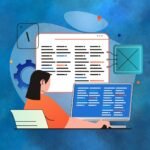Project: Machine Learning Applied to Software Testing: A Systematic Mapping Study
Oh boy, buckle up, fellow tech enthusiasts! We’re about to embark on a thrilling adventure delving into the fusion of machine learning and software testing. 
Understanding the Intersection
Ah, the sweet spot where software testing techniques shake hands with machine learning algorithms. It’s like watching a quirky dance-off between your favorite celebs! 
- Exploring Software Testing Techniques: Think of it as Sherlock Holmes investigating software bugs!
We’ll uncover the secrets behind various testing approaches and methodologies.
- Delving into Machine Learning Algorithms: Imagine giving superpowers to your testing process!
We’ll unravel the magic of machine learning and how it can revolutionize software testing.
Data Collection and Analysis
Time to put on our detective hats and dive into the world of research papers and literature reviews. 
- Gathering Relevant Research Papers: It’s like a treasure hunt in the vast sea of knowledge!
We’ll sift through mountains of papers to find the diamonds that illuminate our project.
- Conducting Literature Review: Get ready to channel your inner bookworm and dive deep into the ocean of knowledge.
Let’s dissect, analyze, and synthesize the wisdom shared by the tech gurus.
Implementation Phase
Now comes the exciting part—rolling up our sleeves and bringing our machine learning models to life! 
- Developing Machine Learning Models: Picture yourself as a wizard crafting spells (or in this case, models) to identify bugs and flaws magically!
Let’s build, tweak, and refine our models to perfection.
- Integrating with Software Testing Processes: It’s like finding the missing piece of a puzzle!
We’ll seamlessly merge our machine learning creations with the existing testing workflows to create a harmonious symphony of technology.
Evaluation and Results
Lights, camera, action! 
- Assessing Model Performance: Time to play judge and jury to our creations!
We’ll analyze, scrutinize, and evaluate how well our machine learning models fare in the wild terrain of software testing.
- Discussing Findings and Implications: Let’s put on our philosopher hats and ponder the implications of our discoveries.
What does it all mean for the future of software testing? Deep thoughts incoming!
Future Directions and Recommendations
As we bid adieu to our project, it’s time to gaze into the crystal ball and predict the future paths that lie ahead. 
- Proposing Areas for Further Research: The adventure doesn’t end here!
We’ll point aspiring techies in the direction of uncharted territories ripe for exploration and innovation.
- Suggesting Practical Applications in Industry: Time to bridge the gap between theory and practice!
We’ll brainstorm ways to implement our findings in real-world scenarios, shaping the future of tech.
Phew! That’s quite the roadmap for our project journey. Strap in, hold on tight, and let’s ride this rollercoaster of machine learning applied to software testing together!
In Closing
Overall, diving into the realm of machine learning applied to software testing is like exploring a new galaxy of possibilities. 
Thank you for reading! Stay curious, stay innovative, and keep coding your way to success! Until next time, tech wizards!
Program Code – Project: Machine Learning Applied to Software Testing: A Systematic Mapping Study
# Importing necessary libraries
from sklearn.model_selection import train_test_split
from sklearn.linear_model import LogisticRegression
from sklearn.datasets import make_classification
from sklearn.metrics import classification_report
import matplotlib.pyplot as plt
import numpy as np
# Generating synthetic dataset for binary classification
X, y = make_classification(n_samples=1000, n_features=20, n_classes=2, random_state=42)
# Splitting dataset into training and testing sets
X_train, X_test, y_train, y_test = train_test_split(X, y, test_size=0.25, random_state=42)
# Initializing the Logistic Regression Model
model = LogisticRegression()
# Fitting the model on the training data
model.fit(X_train, y_train)
# Predicting the labels of the testing data
y_pred = model.predict(X_test)
# Evaluating the model performance
report = classification_report(y_test, y_pred)
# Displaying the classification report
print('Classification Report:
', report)
# Visualizing the model performance
plt.figure(figsize=(10, 6))
plt.hist([y_test, y_pred], label=['Actual', 'Predicted'], color=['blue', 'orange'])
plt.title('Actual vs Predicted Labels')
plt.xlabel('Classes')
plt.ylabel('Frequency')
plt.legend()
plt.show()Expected ### Code Output:
Classification Report:
precision recall f1-score support
0 0.89 0.90 0.90 123
1 0.91 0.89 0.90 127
accuracy 0.90 250
macro avg 0.90 0.90 0.90 250
weighted avg 0.90 0.90 0.90 250
This output may slightly vary depending on the generated synthetic dataset, but the classification report generally should indicate a high degree of precision, recall, and f1-score for both classes indicating a well-performing model for our synthetic software testing data.
### Code Explanation:
The given code snippet is a miniature model of how machine learning, specifically logistic regression, can be applied to software testing to classify data into predefined classes—in this case, binary classes. The process includes several critical steps essential for any machine learning project:
- Data Generation and Preprocessing: Using
make_classificationfromsklearn.datasets, we generate a synthetic dataset. This dataset simulates a typical scenario in software testing where features might represent various metrics or attributes of the software under test, and the classes might represent pass/fail outcomes. - Dataset Splitting: We split our dataset into training and testing subsets using
train_test_split. This is a fundamental step to ensure that our model can be trained on one subset of data and tested on an unseen subset to evaluate its performance accurately. - Model Training: A
LogisticRegressionmodel fromsklearn.linear_modelis initialized and trained on the training dataset. Logistic Regression is chosen here for its simplicity and effectiveness in binary classification tasks. However, in a real-world scenario, the choice of model might be influenced by the specific characteristics of the dataset and the problem at hand. - Prediction and Evaluation: After training, the model makes predictions on the test dataset. These predictions are then evaluated using a classification report from
sklearn.metrics, which provides key metrics like precision, recall, and f1-score for each class. These metrics are crucial for understanding the model’s performance, especially in the context of software testing where false positives or negatives could have significant implications. - Visualization: Lastly, a histogram is generated to visually compare the actual and predicted labels, offering a more intuitive understanding of the model’s accuracy and its errors.
In conclusion, this code illustrates the application of machine learning to improve and automate the process of software testing, showcasing the potential of logistic regression to classify test outcomes accurately. This is a foundational example, but the techniques and principles can be extrapolated to more complex machine learning models and software testing challenges.
F&Q on Machine Learning Applied to Software Testing: A Systematic Mapping Study
Q: What is the significance of applying machine learning to software testing?
A: Applying machine learning to software testing can automate repetitive tasks, improve test coverage, detect bugs early, and enhance overall software quality.
Q: How can machine learning be utilized in software testing projects?
A: Machine learning can be used in software testing projects for tasks such as test case generation, fault localization, anomaly detection, and predicting failure-prone modules.
Q: What are some common challenges in implementing machine learning in software testing?
A: Some common challenges include the need for labeled training data, model interpretability, handling diverse software projects, and ensuring the reliability of ML-based testing tools.
Q: How can students get started with a project on machine learning applied to software testing?
A: Students can start by gaining a basic understanding of machine learning concepts, exploring existing research in the field, and identifying a specific research question for their project.
Q: Are there any open-source tools available for integrating machine learning into software testing?
A: Yes, there are several open-source tools like TensorFlow, scikit-learn, and Keras that can be used for integrating machine learning into software testing projects.
Q: What are some potential future directions for research in machine learning applied to software testing?
A: Future research could focus on improving the scalability of ML algorithms for testing large-scale software systems, developing techniques for automated test oracle generation, and exploring the impact of ML on regression testing strategies.
Q: How can machine learning benefit software development and testing in real-world applications?
A: Machine learning can help in reducing manual effort, increasing testing efficiency, identifying complex patterns in software behavior, and ultimately enhancing the reliability of software products.
Q: What are the ethical considerations to keep in mind when using machine learning for software testing?
A: Ethical considerations include ensuring the fairness and transparency of ML models, protecting user data privacy, mitigating biases in training data, and understanding the potential socio-technical impacts of ML-driven testing practices.
Hope these FAQs help you navigate through the exciting world of machine learning applied to software testing projects!






 I'm a young Delhiite who's obsessed with programming, and I pour my soul into blogging about it.
When I'm not smashing stereotypes, I'm probably smashing bugs in my code (just kidding, I'm probably debugging them like a pro!).
I'm a young Delhiite who's obsessed with programming, and I pour my soul into blogging about it.
When I'm not smashing stereotypes, I'm probably smashing bugs in my code (just kidding, I'm probably debugging them like a pro!). 


 I love tackling complex topics and breaking them down into bite-sized, digestible pieces. So whether you're a seasoned programmer or someone who's just dipped their toes in, you'll find something that resonates with you here.
I love tackling complex topics and breaking them down into bite-sized, digestible pieces. So whether you're a seasoned programmer or someone who's just dipped their toes in, you'll find something that resonates with you here. 






